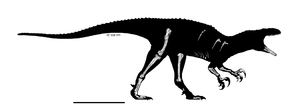- Australovenator
-
Australovenator
Temporal range: Early Cretaceous, 100 Ma
Silhouette with known skeletal elements Scientific classification 
Phylum: Chordata Class: Reptilia Superorder: Dinosauria Order: Saurischia Suborder: Theropoda Family: †Neovenatoridae Branch: †Megaraptora Genus: †Australovenator
Hocknull et al., 2009Species: †A. wintonensis Binomial name Australovenator wintonensis
Hocknull et al., 2009Australovenator (meaning "southern hunter") is a genus of allosauroid theropod dinosaur from late Albian (Early Cretaceous)-age rocks of Australia. It is known from partial cranial and postcranial remains which were described in 2009 by Scott Hocknull and colleagues.
Description and history
Australovenator is based on AODL 604 (affectionately named "Banjo") a partial skeleton including a left dentary, teeth, partial forelimbs and hindlimbs, a partial right ilium, ribs, and gastralia. Australovenator was described in 2009 by paleontologist Scott Hocknull of the Queensland Museum, and colleagues. The type species is A. wintonensis, in reference to nearby Winton. A phylogenetic analysis found Australovenator to be an allosauroid carnosaurian, with similarities to Fukuiraptor and carcharodontosaurids. In the initial analysis, it was shown to be the sister taxon of the Carcharodontosauridae.[1] More detailed studies found that it formed a clade with several other carcharodontosaurid-like allosaurs, the Neovenatoridae.[2]
The ankles of Australovenator and Fukuiraptor are similar to the Australian talus bone known as NMVP 150070 that had previously been identified as belonging to Allosaurus sp., and it is likely that this bone represents Australovenator or a close relative of it.[1][3] Alternatively, this bone could belong to an abelisaur.[4]
Paleobiology
AODL 604 was found about 60 kilometres (37 mi) northwest of Winton, near Elderslie Station. It was recovered from the lower part of the Winton Formation, dated to the latest Albian. AODL 604 was found in a clay layer between sandstone layers, interpreted as an oxbow lake, or billabong, deposit. Also found at the site were the type specimen of the sauropod Diamantinasaurus, bivalves, fish, turtles, crocodilians, and plant fossils. The Winton Formation had a faunal assemblage including bivalves, gastropods, insects, the lungfish Metaceratodus, turtles, the crocodilian Isisfordia, pterosaurs, and several types of dinosaurs, such as the sauropods Diamantinasaurus and Wintonotitan, and unnamed ankylosaurians and hypsilophodonts. Plants known from the formation include ferns, ginkgoes, gymnosperms, and angiosperms.[1]
Australovenator was a medium-sized allosauroid.[1] According to Hocknull, it was 2 metres (6.6 ft) tall at the hip and 6 metres (20 ft) long. Because it was a lightweight predator, he coined it as the "cheetah of its time".[5] Like other carnosaurians, Australovenator would have been a bipedal carnivore.[6]
References
- ^ a b c d Hocknull, Scott A.; White, Matt A.; Tischler, Travis R.; Cook, Alex G.; Calleja, Naomi D.; Sloan, Trish; and Elliott, David A. (2009). Sereno, Paul. ed. "New Mid-Cretaceous (Latest Albian) Dinosaurs from Winton, Queensland, Australia". PLoS ONE 4 (7): e6190. doi:10.1371/journal.pone.0006190. PMC 2703565. PMID 19584929. http://www.pubmedcentral.nih.gov/articlerender.fcgi?tool=pmcentrez&artid=2703565.
- ^ Benson, R.B.J.; Carrano, M.T; Brusatte, S.L. (2010). "A new clade of archaic large-bodied predatory dinosaurs (Theropoda: Allosauroidea) that survived to the latest Mesozoic". Naturwissenschaften 97 (1): 71–78. Bibcode 2010NW.....97...71B. doi:10.1007/s00114-009-0614-x. PMID 19826771.
- ^ Molnar, Ralph E.; Flannery, Timothy F.; and Rich, Thomas H.V. (1981). "An allosaurid theropod dinosaur from the Early Cretaceous of Victoria, Australia". Alcheringa 5 (2): 141–146. doi:10.1080/03115518108565427.
- ^ Agnolin, F. L.; Ezcurra, M. D.; Pais, D. F.; and Salisbury, S. W. (2010). "A reappraisal of the Cretaceous non-avian dinosaur faunas from Australia and New Zealand: Evidence for their Gondwanan affinities". Journal of Systematic Palaeontology 8 (2): 257–300. doi:10.1080/14772011003594870.
- ^ Scientists discover 3 new Aussie dinosaurs. ABC News. July 3, 2009
- ^ Holtz, Thomas R., Jr.; Molnar, Ralph E.; and Currie, Philip J. (2004). Weishampel, David B.; Dodson, Peter; and Osmólska, Halszka (eds.). ed. The Dinosauria (2nd ed.). Berkeley: University of California Press. pp. 71–110. ISBN 0-520-24209-2.
Categories:- Carnosaurs
- Cretaceous dinosaurs
- Dinosaurs of Australia
- Fossil taxa described in 2009
Wikimedia Foundation. 2010.


